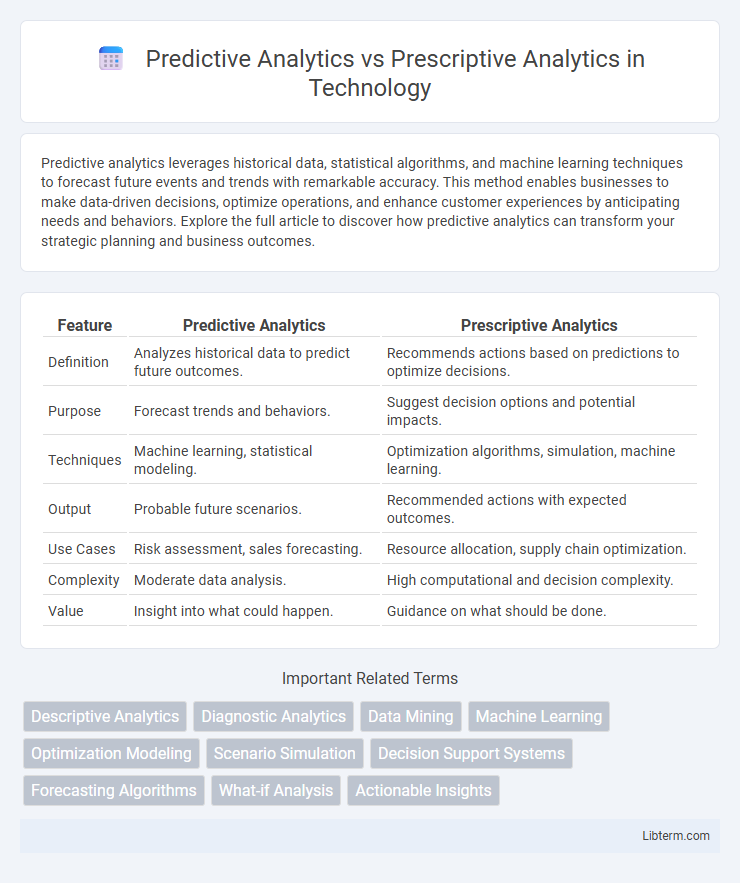Predictive analytics leverages historical data, statistical algorithms, and machine learning techniques to forecast future events and trends with remarkable accuracy. This method enables businesses to make data-driven decisions, optimize operations, and enhance customer experiences by anticipating needs and behaviors. Explore the full article to discover how predictive analytics can transform your strategic planning and business outcomes.
Table of Comparison
| Feature | Predictive Analytics | Prescriptive Analytics |
|---|---|---|
| Definition | Analyzes historical data to predict future outcomes. | Recommends actions based on predictions to optimize decisions. |
| Purpose | Forecast trends and behaviors. | Suggest decision options and potential impacts. |
| Techniques | Machine learning, statistical modeling. | Optimization algorithms, simulation, machine learning. |
| Output | Probable future scenarios. | Recommended actions with expected outcomes. |
| Use Cases | Risk assessment, sales forecasting. | Resource allocation, supply chain optimization. |
| Complexity | Moderate data analysis. | High computational and decision complexity. |
| Value | Insight into what could happen. | Guidance on what should be done. |
Introduction to Predictive and Prescriptive Analytics
Predictive analytics uses historical data, statistical algorithms, and machine learning techniques to forecast future outcomes and trends, enabling businesses to anticipate customer behavior, market shifts, and potential risks. Prescriptive analytics extends beyond prediction by recommending actions based on predictive insights, optimizing decision-making through advanced modeling, simulation, and optimization methods. Together, these analytics forms empower organizations to not only foresee events but also determine the best courses of action to achieve desired business objectives.
Defining Predictive Analytics
Predictive analytics uses historical data, statistical algorithms, and machine learning techniques to forecast future outcomes and trends. It identifies patterns and predicts the likelihood of events, providing actionable insights for decision-making in industries like finance, healthcare, and marketing. By analyzing past behaviors, predictive analytics enables businesses to optimize strategies and reduce risks effectively.
Defining Prescriptive Analytics
Prescriptive analytics uses data, algorithms, and machine learning to recommend specific actions for optimal outcomes, going beyond predictive analytics' forecast of future events. It integrates insights from predictive models with business rules and constraints to provide actionable strategies in real time. Industries like healthcare, finance, and supply chain benefit from prescriptive analytics by improving decision-making and operational efficiency.
Key Differences Between Predictive and Prescriptive Analytics
Predictive analytics uses historical data and statistical algorithms to forecast future outcomes and identify potential trends, focusing on what might happen. Prescriptive analytics goes beyond prediction by recommending specific actions to achieve desired results, leveraging optimization and simulation techniques. The key difference lies in predictive analytics providing insights into future possibilities, while prescriptive analytics delivers actionable strategies to influence those outcomes.
Core Techniques Used in Predictive Analytics
Predictive analytics primarily utilizes statistical modeling, machine learning algorithms, and data mining techniques to forecast future outcomes based on historical data patterns. Core techniques include regression analysis, decision trees, neural networks, and time series analysis, which help identify trends and probabilities for informed decision-making. These methods enable businesses to anticipate customer behavior, optimize operations, and mitigate risks by leveraging predictive insights.
Core Techniques Used in Prescriptive Analytics
Prescriptive analytics employs core techniques such as optimization algorithms, simulation modeling, and decision analysis to recommend the best course of action based on data insights. It integrates machine learning models with mathematical programming methods like linear programming and Monte Carlo simulation to identify optimal solutions under uncertainty. These techniques enable businesses to make data-driven decisions that maximize outcomes and minimize risks.
Use Cases for Predictive Analytics
Predictive analytics leverages historical data and machine learning algorithms to forecast future outcomes, making it essential for use cases such as customer churn prediction, demand forecasting, and fraud detection. Industries like retail and finance utilize predictive models to optimize inventory management and assess credit risk, enhancing decision-making accuracy. These applications enable proactive strategies that minimize risks and capitalize on emerging opportunities by anticipating trends and behaviors.
Use Cases for Prescriptive Analytics
Prescriptive analytics is extensively used in supply chain management to optimize inventory levels and reduce costs by recommending specific actions based on predictive data. In healthcare, it guides treatment plans by analyzing patient data to suggest the most effective therapies and interventions. Financial services leverage prescriptive analytics for fraud detection and risk management by prescribing real-time responses to potential threats.
Challenges in Implementing Predictive and Prescriptive Analytics
Challenges in implementing predictive and prescriptive analytics include data quality issues, which affect the accuracy of predictive models and the effectiveness of prescriptive recommendations. Integrating advanced analytics into existing IT infrastructure requires significant investment in technology and skilled personnel capable of managing complex algorithms and interpreting results. Ensuring data privacy and complying with regulations complicate deployment, while aligning analytics outcomes with business objectives demands continuous collaboration between technical teams and decision-makers.
Choosing the Right Analytics Approach for Your Business
Predictive analytics uses historical data and statistical models to forecast future outcomes, helping businesses anticipate trends and customer behaviors. Prescriptive analytics goes a step further by recommending actions based on these predictions, optimizing decision-making and resource allocation. Selecting the right approach depends on business goals: use predictive analytics for insights and forecasting, while prescriptive analytics suits organizations seeking actionable strategies to improve operational efficiency and competitive advantage.
Predictive Analytics Infographic

 libterm.com
libterm.com